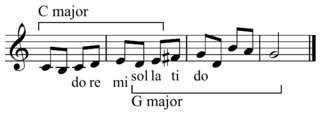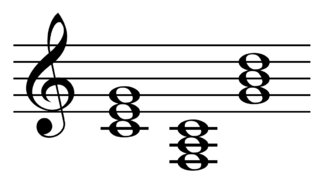
The major scale is one of the most commonly used musical scales, especially in Western music. It is one of the diatonic scales. Like many musical scales, it is made up of seven notes: the eighth duplicates the first at double its frequency so that it is called a higher octave of the same note.
In a musical composition, a chord progression or harmonic progression is a succession of chords. Chord progressions are the foundation of harmony in Western musical tradition from the common practice era of Classical music to the 21st century. Chord progressions are the foundation of popular music styles, traditional music, as well as genres such as blues and jazz. In these genres, chord progressions are the defining feature on which melody and rhythm are built.
In music, the subdominant is the fourth tonal degree of the diatonic scale. It is so called because it is the same distance below the tonic as the dominant is above the tonic – in other words, the tonic is the dominant of the subdominant. It also happens to be the note one step below the dominant. In the movable do solfège system, the subdominant note is sung as fa.

In music, modulation is the change from one tonality to another. This may or may not be accompanied by a change in key signature. Modulations articulate or create the structure or form of many pieces, as well as add interest. Treatment of a chord as the tonic for less than a phrase is considered tonicization.
Modulation is the essential part of the art. Without it there is little music, for a piece derives its true beauty not from the large number of fixed modes which it embraces but rather from the subtle fabric of its modulation.
A secondary chord is an analytical label for a specific harmonic device that is prevalent in the tonal idiom of Western music beginning in the common practice period: the use of diatonic functions for tonicization.
In music, the mediant is the third scale degree of a diatonic scale, being the note halfway between the tonic and the dominant. In the movable do solfège system, the mediant note is sung as mi. While the fifth scale degree is almost always a perfect fifth, the mediant can be a major or minor third.
In music, the submediant is the sixth degree of a diatonic scale. The submediant is named thus because it is halfway between the tonic and the subdominant or because its position below the tonic is symmetrical to that of the mediant above.

In music, the supertonic is the second degree of a diatonic scale, one whole step above the tonic. In the movable do solfège system, the supertonic note is sung as re.
In music, function is a term used to denote the relationship of a chord or a scale degree to a tonal centre. Two main theories of tonal functions exist today:
In music theory, a dominant seventh chord, or major minor seventh chord, is a seventh chord, usually built on the fifth degree of the major scale, and composed of a root, major third, perfect fifth, and minor seventh. Thus it is a major triad together with a minor seventh, denoted by the letter name of the chord root and a superscript "7". An example is the dominant seventh chord built on G, written as G7, having pitches G–B–D–F:

In music, a closely related key is one sharing many common tones with an original key, as opposed to a distantly related key. In music harmony, there are six of them: four of them share all the pitches with a key with which it is being compared, one of them share all except one, and one shares the same tonic.
In Western music, the adjectives major and minor may describe an interval, chord, scale, or key. A composition, movement, section, or phrase may also be referred to by its key, including whether that key is major or minor.

The Andalusian cadence is a term adopted from flamenco music for a chord progression comprising four chords descending stepwise – a iv–III–II–I progression with respect to the Phrygian mode or i–VII–VI–V progression with respect to the Aeolian mode (minor). It is otherwise known as the minor descending tetrachord. Traceable back to the Renaissance, its effective sonorities made it one of the most popular progressions in classical music.

In music, a primary triad is one of the three triads, or three-note chords built from major or minor thirds, most important in tonal and diatonic music, as opposed to an auxiliary triad or secondary triad.

In musical tuning and harmony, the Tonnetz is a conceptual lattice diagram representing tonal space first described by Leonhard Euler in 1739. Various visual representations of the Tonnetz can be used to show traditional harmonic relationships in European classical music.

In music, chromatic mediants are "altered mediant and submediant chords." A chromatic mediant relationship defined conservatively is a relationship between two sections and/or chords whose roots are related by a major third or minor third, and contain one common tone. For example, in the key of C major the diatonic mediant and submediant are E minor and A minor respectively. Their parallel majors are E major and A major. The mediants of the parallel minor of C major are E♭ major and A♭ major. Thus, by this conservative definition, C major has four chromatic mediants: E major, A major, E♭ major, and A♭ major.

Neo-Riemannian theory is a loose collection of ideas present in the writings of music theorists such as David Lewin, Brian Hyer, Richard Cohn, and Henry Klumpenhouwer. What binds these ideas is a central commitment to relating harmonies directly to each other, without necessary reference to a tonic. Initially, those harmonies were major and minor triads; subsequently, neo-Riemannian theory was extended to standard dissonant sonorities as well. Harmonic proximity is characteristically gauged by efficiency of voice leading. Thus, C major and E minor triads are close by virtue of requiring only a single semitonal shift to move from one to the other. Motion between proximate harmonies is described by simple transformations. For example, motion between a C major and E minor triad, in either direction, is executed by an "L" transformation. Extended progressions of harmonies are characteristically displayed on a geometric plane, or map, which portrays the entire system of harmonic relations. Where consensus is lacking is on the question of what is most central to the theory: smooth voice leading, transformations, or the system of relations that is mapped by the geometries. The theory is often invoked when analyzing harmonic practices within the Late Romantic period characterized by a high degree of chromaticism, including work of Schubert, Liszt, Wagner and Bruckner.
In music, the dominant is the fifth scale degree of the diatonic scale. It is called the dominant because it is second in importance to the first scale degree, the tonic. In the movable do solfège system, the dominant note is sung as "So(l)".
Carl Friedrich Weitzmann was a German music theorist and musician.

Parallel and counter parallel chords are terms derived from the German to denote what is more often called in English the "relative", and possibly the "counter relative" chords. In Hugo Riemann's theory, and in German theory more generally, these chords share the function of the chord to which they link: subdominant parallel, dominant parallel, and tonic parallel. Riemann defines the relation in terms of the movement of one single note:
The substitution of the major sixth for the perfect fifth above in the major triad and below in the minor triad results in the parallel of a given triad. In C major thence arises an apparent A minor triad, D minor triad (Sp), and E minor triad (Dp).
: CM and EM chords Play (help*info)
. DSp in C major.png](http://upload.wikimedia.org/wikipedia/commons/thumb/b/bb/DSp_in_C_major.png/220px-DSp_in_C_major.png)
 Play (help·info).
Play (help·info).









